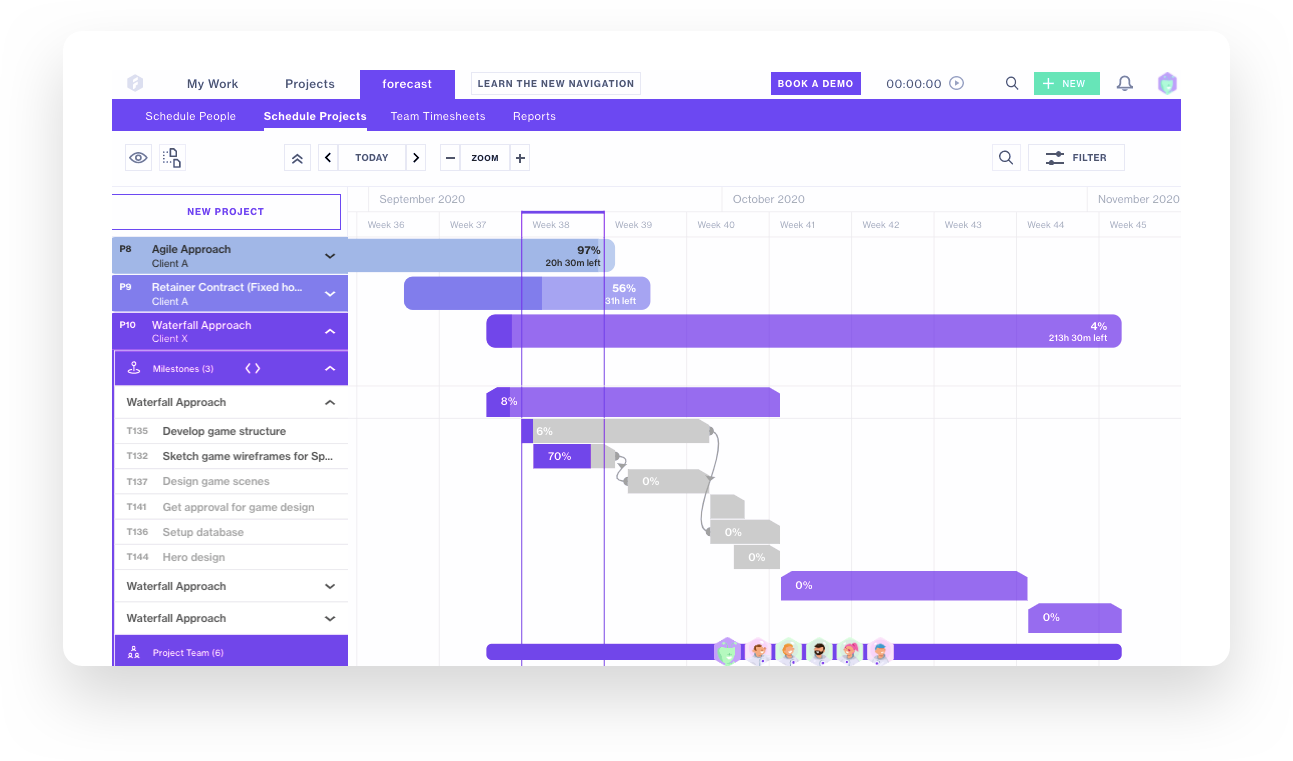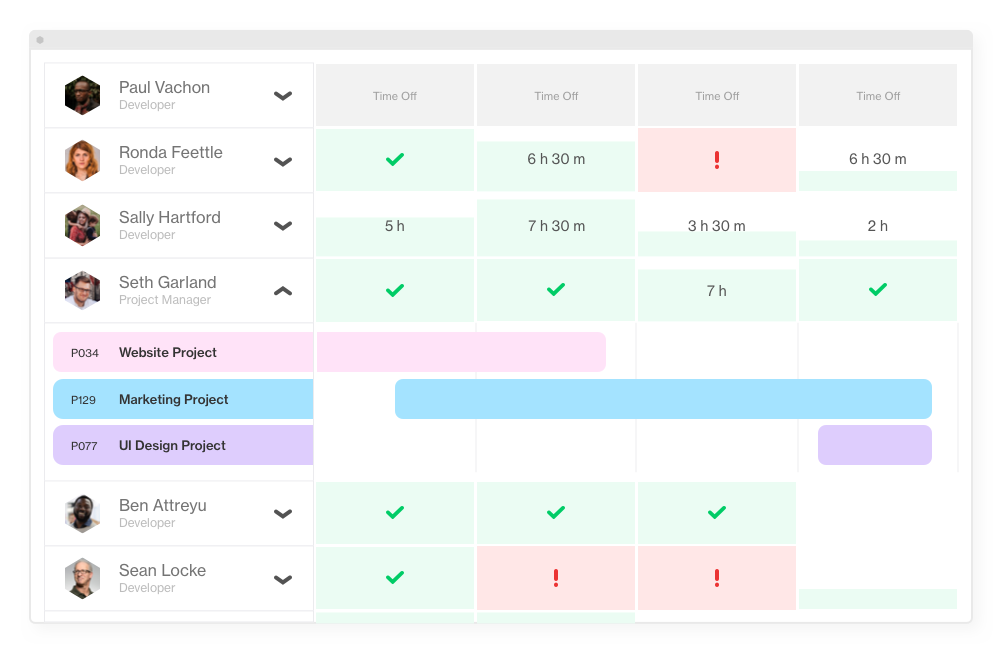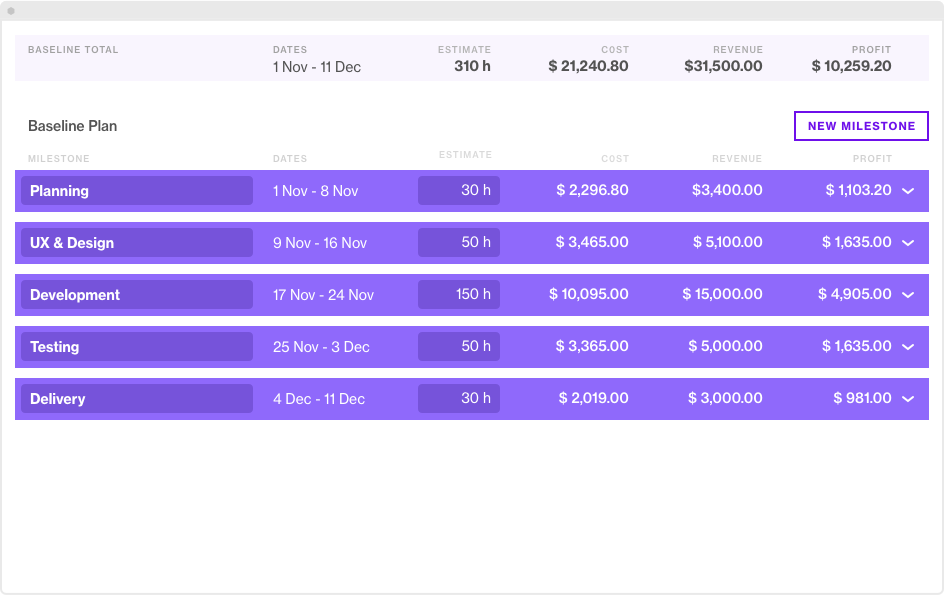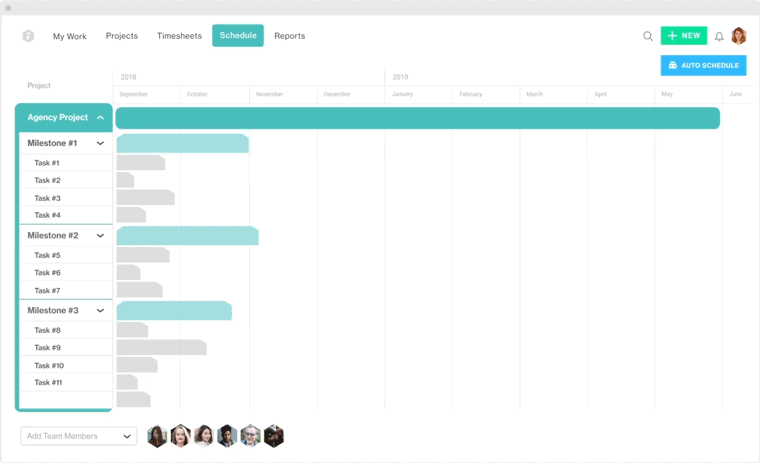The Complete Project Planning Tutorial

Project planning is an integral part of project management. No matter the size, structure, or complexity of your projects, efficient planning can make a world of difference to project success. A recent report by the PMI found that the companies that undervalue the importance of well-rounded project management report an average of 67% more of their projects failing.
No doubt, a good project management planning process will always take effort and time. But not doing it means running the risk of project failure, poor communication, financial losses, low stakeholder satisfaction rates, missed deadlines, and other issues you can otherwise avoid. Planning your projects and using advanced project planning software will help you stay ahead of your competitors and be in control of the workflow at all times, keeping you in shape for ad-hoc situations that can delay or even ruin projects.
However, there is more to project planning than simply a timeline of activities or the creation of Gantt charts. In other words, it isn’t as simple as A-B-C. There are quite a few things you need to know about planning to get started with your projects so here is the ultimate project planning guide for you to keep in your back pocket at all times.
- What is project planning?
- The importance of project planning
- Getting started with project planning
- Key project planning documents
- The length of the project planning phase
- Project planning terms
- How to create a project plan
- Common project planning challenges
What is project planning?
Project planning is a crucial step that follows project initiation and precedes its execution. When working on project management planning, you get to define all the available resources, potential pitfalls and risks, scope, deliverables, timing, costs, and any other component that can impact project success. It basically helps you disassemble the upcoming project into stages, getting a clear look at future needs and setting a project baseline. The latter is something of a reference center you can check anytime to see if your project is meeting the initial planning.
With a clear project plan at hand, you can always compare your actual progress with initial calculations and be sure to finish everything on time and within budget. Instead of “figuring something out” when the project is already running, you can take the driver’s seat from the get-go. Here is why you don’t want to miss this chance.
The importance of project planning
A recent report by the PMI states that 9.9% of every dollar gets wasted because of poor project performance, but that’s a number you can drastically reduce by adopting an effective project planning methodology. If you are still not sure whether it really is necessary to go the extra mile and plan your projects, this is how you can benefit from doing it.
Setting clear goals and strategies
Initiating a project and then letting it go with the flow is just as risky as it sounds. It will get you buried in messy data, numerous data reporting requests, unclear objectives, and unrealistic goals. However, by seizing that planning phase of project management you can be sure that the whole team is on the same page as to where they are going and how they can get there, executing the overall strategy and vision of the company. 
Forecast is an all-in-one solution for planning, managing, and tracking projects.
Reducing risks and failure rates
Projects are always beset with risks, quite possibly overloading you with ad-hoc requests and force majeure situations, which, in turn, can hurt project managers’ credibility. Using cutting-edge project planning tools and innovative strategies is how you always stay one step ahead of the project flow and anything that can undermine it.
Planning resources effectively
Having a solid resource planning strategy can help you avoid overloading your team or leaving someone on standby. When comparing the initial plan to the actual progress you’ll be able to track your project performance, taking the necessary steps to level it up, and determining when and if your project team really needs to hire new people.
86f8.png)
Keeping projects on budgets
A McKinsey study found that 66% of enterprise software projects exceed their budget. This is another reason for going through all the project planning stages, including budget planning. To see the big picture, you need to forecast project profitability and calculate project price early on.
Managing stakeholders
Getting all the stakeholders on the same wavelength might be one of the most complicated parts of any project planning process, but without it, your project might be vulnerable. A working plan will always help you make the project transparent. It will set a single vision for the team, establish clear expectations and realistic goals for the project, and develop effective communication among all the stakeholders and team members. Not to mention that you'll be able to speak to your stakeholders on the individual level.
Achieving transparency & improving communication
Communication and transparency are key when planning a project. Getting unfiltered information and having to constantly ask the project team for progress updates are among the main pain points of PM experts. This is why project plans feel like a breath of fresh air to those who manage to establish transparent communication among all the stakeholders.
Getting started with project planning
To ease your team and yourself into that project planning process, see if you can give exhaustive answers to this set of questions:
- Why are you launching the project? Outline your goals.
- What would be the expected deliverables and outputs?
- When do you want to have it finished?
- How are you going to get there, using what methodology?
- Who are your stakeholders and clients?
Unless you work on the very basics of your project plan outline first, you’ll have to Houdini yourself out of many unforeseen traps and challenges later on. But with that primary step covered, you can move on to draft the main project planning documents.
Key project planning documents
For the project not to stop dead in its tracks when you least expect it, here are the documents you need to have on the table prior to project launch:
- Project charter is usually a short formal document giving a brief description of the whole project, its goals and ways to reach them as well as the stakeholders that will be involved in the process. This is the document that gets revisited multiple times during the lifecycle of the project so it’s good to have it as your baseline.
- Statement of work, more commonly known as “scope of work”, is another project management planning document that explains what constitutes the project in the tiniest detail by describing specific activities, deliverables and timelines lined up on the horizon.
- Work-breakdown structure, as the name suggests, is a combination of small components, all of which make up a single project. Such a structure helps break down your project into manageable milestones and deliverables.
- Project plan stands for a series of documents focused on defining specific project stages like execution and control. It helps you work out risk management approaches, resource management strategies, cost, scope, and project baselines.
Keep in mind that a working project plan is always more than a bunch of excel sheets telling you what needs to be done by what day. Ideally, it is a top to bottom game plan that reduces any potential need for hand-holding and keeps all the stakeholders on the same page as to what is going on with the project. On top of that, your project plan should give the client a realistic view of the project, accompanied by all the necessary estimates and a complete statement of work.
The length of the project planning phase
More often than not, clients and stakeholders are eager to learn how long it will take to see actionable project plans. Although there is no specific time label you can put on that project planning stage, that doesn’t mean there is nothing you can do to give a ballpark estimate. There is a tried and tested approach here: you look at all the data from some similar projects you have already curated and the time it took to plan them out from top to bottom. Using some project planning tools will help you make that estimate as accurate as possible, especially if they are driven by machine learning and can do some of that tricky prediction job for you.
NB: Getting a feasibility report before you start planning will help you reduce the amount of time needed to complete that project planning phase and potentially save your client and yourself a good deal of money. Such a report is based on a custom-made feasibility study, aimed at finding out how likely the project is to succeed altogether. The study analyzes your project goals, potential pitfalls and ways to tackle them, budget, resources, and other components that are crucial for project success.
Project planning terms
Always keep this glossary at the ready to take to project planning like a duck to water.
- Stakeholder — anyone who is directly or indirectly involved in the project. Your project team, sponsors and executives, end-users or customers — all of these are part of the stakeholder group.
- Deliverable — the end product or a product part you have to provide to the stakeholder or client in accordance to your agreement.
- Milestone — a key event or point in the lifecycle of the project, which usually helps to track its progress.
- Scope — everything to be achieved or delivered for the project to end in success.
- Timeline — an indicator that usually shows all the project events in sequential order, making it easy to understand what the team has to do over the time of the project lifecycle.
- Dependencies — indicators showing the relationship between different project components (like tasks or stages) and the order you need to follow when walking through them.
- Task — a piece of work or activity to be completed in order to get closer to reaching the ultimate project goal.
- Subtask — a small component that constitutes a task; it comes in quite handy if the task it belongs to takes several stages and days to finish.
- Resources — all the elements (including relevant experts, facilities, finances, equipment, etc.) that are needed to successfully complete a project.
- Budget — a formally approved document that lists all the financial resources and expenses allocated for the project.
How to create a project plan
Now this is where it gets really interesting. This stage is basically like drafting your own rule book for the project to run like butter when you launch it. Here are the most important steps you don’t want to miss when creating your project management plan.
1. Get to know your resource availability in advance
To be sure your project scope will be covered on time and within the allocated project budget, see if you have available resources for it first. A well-rounded approach to resource management adds transparency and visibility into your project picture, something all stakeholders will appreciate.
The easiest way you can do that is by looking at your project planning software to get real-time data on who is underbooked, fully booked, or overbooked. This is how we do it at Forecast: we give you a clear overview of all team members, their roles and availability on a daily, weekly and monthly basis. You also get to see what project everyone is working on and whether there is any possibility to do some reallocation.

2. Collect project requirements
Sadly but inevitably, lack of agreement on project requirements from day one can often be the cause of unmet expectations. That’s why knowing how to align them when planning a project is paramount.
If you want to plan your project with a magnifying glass and get all the stakeholders to look into it when you’re still drafting your project plan template, consider holding a brainstorming session and working out a Statement of Work (SOW) with your client and key team members. What does that do for you?
Firstly, you get to generate ideas and define project requirements everyone will be aware of right away. Secondly, you set those requirements in stone by communally drafting a document, your SOW, which will outline all the project timelines, activities, and deliverables that make up the project.
3. Outline the project & set a baseline
Now that you have all the requirements and real-time data on your resource availability (the two components most people miss and then try making up for), it is time to focus on outlining your project and setting a baseline.
Outlining the project is like building a carcass for a house. You once again get to look at your project’s feasibility and answer the big questions: is it going to fly? Is it going to be sustainable?
This is the part where you need to split your project into milestones (without getting into too much detail), define roles, and develop a baseline plan. People will keep it as a reference point if they want to evaluate their project progress and performance later on. This baseline is, in its core, a briefly outlined starting point for the project plan. It’s like an initial plan sketch you create together with stakeholders to get clear on project expectations and deliverables.
Here’s what that baseline project plan template looks like in Forecast:

4. Create a project scope
As mentioned earlier, creating a project scope (which is actually another type of outline) will help you define everything you need to achieve and deliver before the end of the project. It lets you dive deep into your project planning and management to break milestones down into tasks and subtasks, estimate tasks, and assign relevant people. Working out your project scope is like creating a mindmap for your stakeholders to see everything you planned for the project to the tiniest detail.
However, it’s crucial that you account for the threats scope creep poses and do the necessary calculations in advance to protect your project from those. In short, scope creep stands for the new unexpected requirements that are going to sneak in after you have already agreed on your project scope and plan.
5. Craft a detailed project schedule
If you thought that your project plan can’t get any more detailed, surprise-surprise: it can. And should, for that matter. Suppose you already have your goals defined, your milestones and tasks outlined — now it’s time to make use of your scheduling skills. The good old Gantt chart will help you visualize all the project components and put them into a single timeline sheet. To be more specific, you’ll get to line up all the milestones, tasks, and dependencies that can either make it or break it for your project success.
To be bluntly honest, scheduling can be a pain in the neck and take up too much of your time. Especially if at some point one dependency causes a mess and makes you manually reschedule the remaining parts of the project. That’s why automating that scheduling process looks like an overwhelmingly attractive feature, which only creme de la creme project planning tools offer.
This is what Auto Schedule looks like in Forecast: in a matter of seconds, our AI will schedule your project from top to bottom, literally saving you several days' worth of work.

6. Make sure there’s a change control process in place
In project management, the change control process means that you are prepared for the fact that there will be changes to the project, both expected and unexpected. You know how to manage them in a controlled and coordinated way because you have a plan B, C, and D at the ready. Change requests can actually look innocent at first, like your client giving feedback and asking for some minor changes. But before you know it, you can end up with several days or even weeks of extra work. And if you are working on a project with a fixed price, chances are high that those extra hours will be non-billable, which means you’ll be doing charity work.
When developing the change control process, you need to try and predict what can go wrong or simply different with the project and how you can work your way out of that scope creep. It’s imperative that you always control all change requests and double-check if they are really necessary and hold tangible value to the project. To make that part easier on yourself and your stakeholders, set up a change management process upfront or at least develop possible scenarios that will get you out of potential trouble.
Common project planning challenges
In 2020, the PMI conducted a survey revealing that 11.4% of investments go down the drain due to poor project performance. Experts have been trying to define project planning in all its colors for decades now but projects still fail. In fact, while developing a complete project plan might take, depending on the size of the project, 3 to 6 months, 39% of them still fail due to poor planning. So why does that happen, you might wonder?
From unrealistic timelines, overlooked requirements, and inadequate resources to underestimated costs and unanticipated complications — all those challenges and many more can still cause project failure. After all, there is a limit to what you can do unaided. But this is where technology enters the picture. Opting for the best project planning software is what sets PM innovators apart from PM laggards, helping them improve stakeholder satisfaction rates, save money, and increase project success stats. Embedded automation removes unnecessary manual work and uncovers blind spots, making project planning faster, easier, and more efficient.
No matter how challenging your market is, effective project planning and management can help you outrun your competitors. With the right approach, you will be able to set clear goals and objectives, establish transparent communication, plan your resources well, reduce failure risks, and avoid financial losses. If you want to see more on the way project planning can benefit your company or are looking to take your planning skills to the next level, be sure to read the following articles for simple guidelines and effective strategies on how to plan projects like a ninja:
You might like to read these articles on our blog..
Subscribe to the Forecast Newsletter
Get a monthly roundup of productivity tips & hacks delivered straight to your inbox
